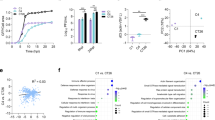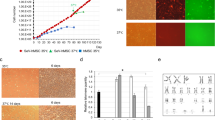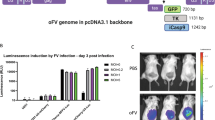Abstract
NEOPLASTIC cells frequently have a karyotype deviant from the normal diploid state1. Transformation of cells in culture by tumour viruses can be used as a model of neoplastic transformation2,3 and is generally considered to be accompanied by extensive changes in chromosome number and morphology4–7. It has not been clear whether these changes are the cause or the result of transformation. It has been suggested that for one DNA tumour virus, simian virus 40 (SV40), the initial step in transformation is the formation of polyploid cells5,8,9 and near-diploid cells in some SV40-transformed cell lines are thought to arise from multipolar mitoses9. In contrast, stable diploid, or occasionally pseudodiploid transformed cell lines have been obtained after transformation by various tumour viruses10–17. Explanations for these apparently contrasting results could be based on differences in the origin of the transformed material18 or on the method of transformation. We have used Chinese hamster Kupffer cell clones to demonstrate that two common methods of isolating transformed cell lines—either from colonies with irregular morphology or from dense foci2—can result in different degrees of karyotypic change in the isolated cell lines.
This is a preview of subscription content, access via your institution
Access options
Subscribe to this journal
Receive 51 print issues and online access
$199.00 per year
only $3.90 per issue
Buy this article
- Purchase on SpringerLink
- Instant access to full article PDF
Prices may be subject to local taxes which are calculated during checkout
Similar content being viewed by others
References
Atkin, N. B. Cytogenetic Aspects of Malignant Transformation (Karger, New York, 1976).
Benjamin, T. L. Meth. Cell Biol. 8, 367–437 (1974).
Tooze, J. The Molecular Biology of Tumor Viruses (Cold Spring Harbor Laboratory, 1973).
Defendi, V. Progr. exp. Tumor Res. 8, 125–188 (1966).
Lehman, J. M. & Defendi, V. J. Virol. 6, 738–749 (1970).
Pontćn, J. Spontaneous and Virus Induced Transformation in Cell Culture (Springer, New York, 1971).
Lehman, J. M. Int. J. Cancer 13, 164–172 (1974).
Hirai, K., Lehman, J. M. & Defendi, V. J. Virol. 8, 828–835 (1971).
Lehman, J. M. & Bloustein, P. Int. J. Cancer 14, 771–778 (1974).
Lavialle, C. H. et al. Archs Virol. 49, 127–139 (1975).
Brailovsky, C., Wicker, R., Suarez, H. G. & Cassingena, R. Int. J. Cancer 2, 133–142 (1967).
Popescu, N. C., Olinici, C. D., Casto, B. C. & Di Paulo, J. A. Int. J. Cancer 14, 461–472 (1974).
Black, P. H. & White, B. J. J. exp. Med. 125, 629–646 (1967).
Defendi, V. & Lehman, J. M. J. cell. comp. Physiol. 66, 351–409 (1965).
Yamamoto, T., Rabinowitz, Z. & Sachs, L. Nature new Biol. 243, 247–250 (1973).
Nachtigal, M., Albrecht, T. & Rapp, F. Intervirology 4, 77–90 (1974).
Kelly, F. Cancer Res. 35, 1210–1213 (1975).
Nachtigal, M., Melnick, J. L. & Butel, J. S. J. natn. Cancer Inst. 47, 35–45 (1971).
Clark, J. M. & Pateman, J. A. Expl Cell Res. (in the press).
Federoff, S. J. natn. Cancer Inst. 38, 607–611 (1967).
Pope, J. H. & Rowe, W. P. J. exp. Med. 120, 121–127 (1964).
Slack, C., Morgan, R. H. M., Carritt, B., Goldfarb, P. S. G. & Hooper, M. L. Expl Cell Res. 98, 1–14 (1976).
Author information
Authors and Affiliations
Rights and permissions
About this article
Cite this article
CLARK, J., PATEMAN, J. Isolation method affects transformed cell line karyotype. Nature 272, 262–264 (1978). https://doi.org/10.1038/272262a0
Received:
Accepted:
Issue date:
DOI: https://doi.org/10.1038/272262a0



